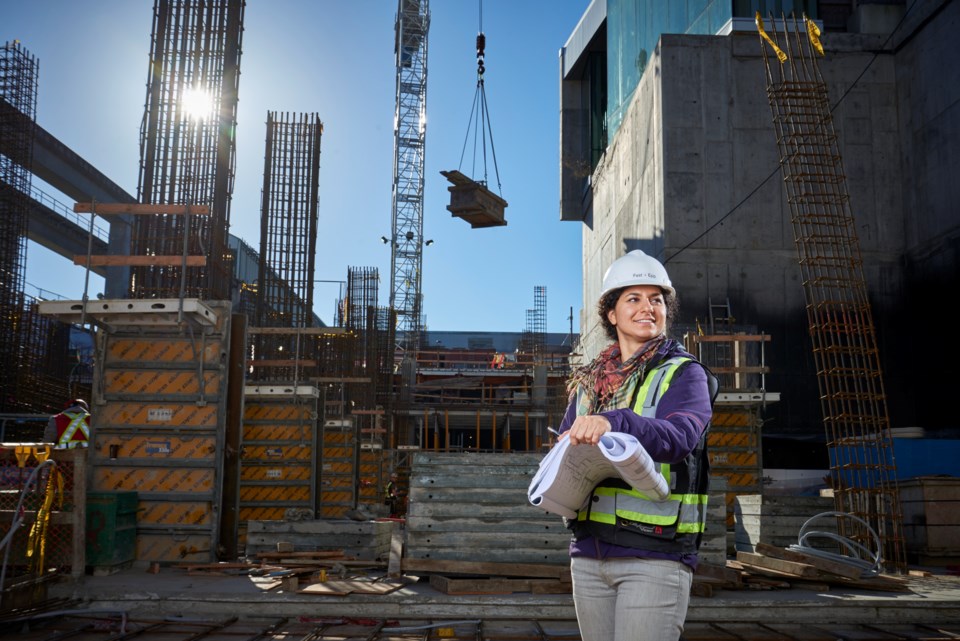Modernizing B.C.’s skilled trades training and apprenticeship programs may be able to help broaden and diversify the construction industry’s talent pool.
Doing so is critical for the industry, which is being squeezed by a labour shortage that is expected to intensify.
While programs exist to connect new workers with employers, there remain barriers to the fuller participation of women and underrepresented groups, according to those who spoke to BIV.
“Employers have to be looking at women, Indigenous Peoples and new Canadians; and even by welcoming those [groups into] the skilled trades workforce, it still not may be enough,” said Tamara Pongracz, head of British Columbia Institute of Technology’s (BCIT) trades access department, and a Red Seal plumber.
The danger of not engaging these groups is the depletion of a workforce with the skills and certifications needed to mentor the next generation, said British Columbia Construction Association (BCCA) president Chris Atchison.
“People who are interested in joining the apprenticeship track are going to be discouraged from advancing or completing their apprenticeship if the barriers for them [to do so] are greater than the opportunities for them to make a living at the present time,” he said.
In B.C., an expected 43,200 workers are expected to retire by 2033—the equivalent of nearly a quarter (23 per cent) of the current labour force, according to a recent report from BuildForce Canada.
To offset this loss, B.C. will need to recruit and train an estimated 54,000 workers.
BCCA announced late last month that the organization had allocated the $15.725 million available through its apprenticeship services program ahead of schedule. The amount was $2.28 million higher than its allocation objective.
“This is moving the needle on the number of newly registered apprentices, and an incredibly positive campaign about the opportunities that exist in the construction industry,” said Atchison.
Funded by the federal government, the program offers cash incentives to hire and register first-year apprentices. It launched in September 2022 and has supported the hiring and registration of 2,075 apprentices in 37 Red Seal trades. Payments were sent to more than 1,020 employers.
It is the most far-reaching construction trade apprenticeship drive ever undertaken in British Columbia, according to the BCCA.
“New registrations in the 25 largest construction trade programs in British Columbia have fluctuated in recent years but have remained below the peak levels observed in 2013,” stated the BuildForce report.
“In 2022, the province saw a substantial recovery in new registrations, returning to the pre-pandemic level. Program completions have been slower to recover, however, remaining below the pre-COVID level in 2022.”
Of the 25 trades identified in the report, 13 of those trades have a demand for certified workers that exceeds the projected number of program completions. These include heavy equipment operators, carpenters, bricklayers and control technicians, among others.
“Based on projected new registrations, several trades are at risk of undersupplying the number of new journeypersons required by 2033,” reads the report.
This labour shortage—while a key issue for the industry—also means that there is space and demand for underrepresented groups in construction and trades, said Pongracz.
Women currently represent five per cent of the total on-site construction employment, according to BuildForce data. Of these women, 29 per cent are directly involved with on-site construction activity and the remaining 71 per cent work in management, office administration, sales, engineering or other off-site positions.
“When you think about it, if [women] are only five per cent of construction and 50 per cent of the workforce, there’s a real opportunity there,” said Jeannine Martin, president of the Vancouver Regional Construction Association.
One barrier that is preventing not only women but parents from entering the skilled trades workforce is a lack of access to affordable, licensed child care, said Pongracz.
“Employers are recognizing that access to affordable child care is a family issue.”
In March, Prime Minister Justin Trudeau announced that the federal government would provide $69.9 million to support the creation of new child-care spaces in B.C. The province said that 930 new spaces would be added to its $10-a-day child-care program.
While this is a “step in the right direction,” child care must also move beyond “banker hours,” said Pongracz.
“As we’re having a skilled shortage, the demands for longer workdays, weekends and extended hours mean that access to childcare, and childcare that’s flexible enough for us to access, is an important piece to opening up opportunities for more folks to enter into those skilled trades,” she said.
At BCIT, 22 of the institute’s 300 trades and apprenticeship training faculty members are women, said Pongracz, adding that those numbers “could be better.”
When asked what the biggest improvement to apprenticeship programs has been in the last few years, she said it is the diversity.
“When I did my apprenticeship, I earned my credentials in 1995, I was always the only female in each of my levels of school. It was quite rare to even see other gals in other classes and what we see is that those numbers have certainly improved,” she said.
“What we’ll be telling is if that increase is maintained in the next couple of years.”
A total of 1,338 construction employers have signed a Builders Code Acceptable Worksite Culture Pledge developed by BCCA and industry partners. The pledge is designed to promote worksite culture, increase worker attraction and retention, and eliminate harassment, bullying, hazing and discrimination.
“What we also have to do is we have to address the culture of some of these workplaces so that we retain them as well. Retention is also key,” Pongracz said.




